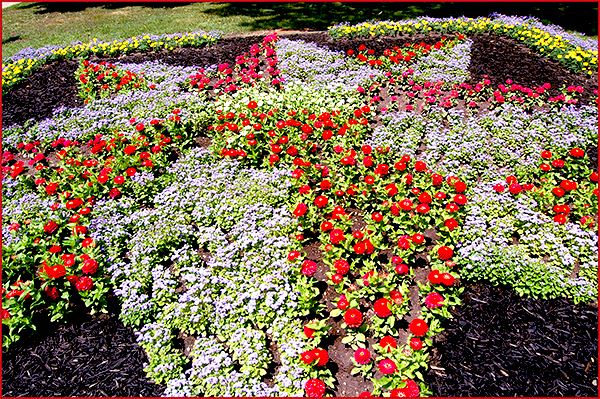Gardens
Ruthmere Museum Quilt Garden Along the Heritage Trail |
|
 2025 Garden - FLYING SWALLOWS AT RUTHMERE | Ruthmere’s quilt garden design for 2025 is “Flying Swallows at Ruthmere,” inspired by frequent feathered visitors to Ruthmere’s quilt garden green. The nearby St. Joseph and Elkhart Rivers create a perfect natural environment for wildlife to thrive, providing water and food sources for multiple species of bird. Around dawn and dusk, you can see swallows diving to catch insects around the quilt garden. Swallows can eat thousands of insects in a single day and help to maintain a balance in our ecosystem. The connection between man and nature has a long history, even in this exact location. In the late 1820s, Elkhart founder Havilah Beardsley was drawn to this area by the water power and its potential uses. He was standing approximately where Ruthmere stands when he decided he would move his family and settle here to build mills. He was undoubtedly surrounded by wildlife, and may have watched a swallow or two diving for insects by the river, just as we do today. Water connects us to nature and is a vital part of our Elkhart ecosystem – Havilah Beardsley used it, the swallows use it, and we continue to depend on water as a clean energy source. This garden consists of white and pink begonias and Aloha Blue ageratum. |
2024 - DISCOVERY IN BLOOM |
The garden consisted of white whisky, rose deep tequila, and red vodka begonias with green FloraMia limon lacy potato vines. |
2023 - THE PARASOL | The 2023 Quilt Garden took inspiration from art found within the walls of the museum. The parasol was a staple of Victorian and Edwardian fashion, helping to protect ladies' delicate skin from the sun and providing a means for them to accessorize. There is a parasol painted on the ceiling of Albert Beardsley's bedroom in Ruthmere, adorned with some of his wife's favorite pink flowers; Ruthmere also has a few 19th-century parasols in its collection. This design featured begonias in pink and white and impomoea potato vine in black and lime. |
2022 - FRIENDSHIP STAR
|  The Ruthmere staff chose the traditional quilt pattern Friendship Star as it speaks to and represents the friendship between Havilah Beardsley and Chief Pierre Moran. The colors of the flowers represent the four colors of mankind: black, white, yellow and red. CELEBRATING 15 YEARS OF QUILT GARDENS Seward Johnson’s sculpture Ready to Make a Break shows a gentleman with a typical Wednesday “honey-do” list, daydreaming about doing exactly as the title reads. |
2021 - UNITY THROUGH DIVERSITY |
Since the Quilt Garden is set amid tall old trees, shade-tolerant coleus, ageratum, celosia, marigolds and gomphrena were chosen. The diverse floral types and colors provide more striking beauty together than any could alone. |
2020 - RUTH'S CHRYSANTHEMUM |
This design features Violet Impatiens, Super Olympia Green Leaf Rose Begonias, Wasabi Coleus, White Impatiens, and Scarlet Wizard Coleus. |
2019 - JOSEPH'S COAT |
This simple design is made memorable by using colorful flowers. Yellow and Orange Taishan Marigolds, Red Cocktail Vodka and White Bronze Leaf Begonias, along with Carpet Blue Petunias fill each tear drop shape with a different color. It is important to note that because Ruthmere is on the National Register of Historic Places, their garden cannot |
2018 - THE BOW TIE |
The garden projects simple elegance and by using just two plant types. You’ll find high contrast and clean lines dominate. In addition, the histories of these plants are in keeping with the time of Ruthmere’s construction. |
2017 - ELKHART FOUNDER HOMESTEAD
|  Honoring Elkhart's founding family Dr. Havilah and Rachel Beardsley, the Elkhart Founder Homestead is a modification of the popular "school house block" design, fashioned and altered slightly to resemble the Havilah Beardsley House located at 102 W. Beardsley Ave., Elkhart. The garden design was inspired by a hand-embroidered sampler made by Mary Ann Beardsley at the age of 12 that hangs in the family sitting room at Havilah Beardsley house. It depicts the house in the late nineteenth century. |
2016 - CROSS CANOES
|
The Crossed Canoes represents the important role that water plays on the Ruthmere Campus with the confluence of the Elkhart River, the St. Joseph River and Christiana Creek. Christiana Creek in particular has become a regional focus as a recreational blueway, and Ruthmere's Creek House Center pictured at left serves as an ideal home base for canoe and kayak clubs looking to tame its waters. |
2015 - POMEGRANATE WINDOW
|
At night we will illuminate one of the south facade occular windows facing Beardsley Avenue with a brillant garnet red light--look for the Pomegranate Window this summer. |
2014 - INFINITY
|
This pattern, with its continuous flowing paths, can be emblematic of the infinite passage of time or the constant bond built by a lifetime of friendship. Albert and Elizabeth may have chosen this pattern to offer a warm welcome to those who entered their home. |
2013 - FLEUR-DE-LIS
|
|
2012 - BLUE & WHITE
|
|
2011 - PRAIRIE ROSE
|  In 2011, Ruthmere's quilt garden design was called "Prairie Rose," a design taken from the iconic prairie stylestained glass windows located inside Ruthmere's main entrance. This window was designed by the architect, E. Hill Turnock, and thought to be inspired by the work of Frank Lloyd Wright. |
2010 - TULIP PATTERN
This is a traditional American pattern that reflects Ruthmere's spring show of tulips through out the Ruthmere grounds.
| 2009 - FLOWER BASKET The Flower Basket design was chosen as it is a pattern of a quilt in our Ruthmere collection. We choose plants that have bright colors and bloom profusely. | 2008 - MARINER'S COMPASS
The Mariner's Compass design, with its distinctive many-pointed medallion is modeled after a quilt owned by the Beardsley Family. |
Kistner-Firstenberger Plaza Garden |
On the north side of the Havilah Beardsley House is the Kistner-Firstenberger Plaza Garden. Great care was taken by Leedy Architects in designing this landscape through the selection and placement of heirloom varieties of flowering plants and shrubs to build an appropriate "thicket garden" to shield the space from Main Street's traffic. Tiled with recycled street paver bricks from Elkhart city streets, this plaza garden is a place to enjoy the peace of nature, while contemplating the geographic significance of the confluence of the St. Joseph and Elkhart Rivers. The Kistner-Firstenberger Plaza Garden received the 2011 Fairbanks Award for Community Beautification from the Greater Elkhart Chamber of Commerce. John and Judy Kistner along with Bill and Lori Firstenberger made gifts to the Havilah Beardsley House to honor their connected families. Arthur W. Kistner was a former resident of the Havilah Beardsley House and held his medical doctor practice there. John Kistner grew up in this house as a child. The Kistner family made several upgrades and changes to the Havilah Beardsley House before moving in. Interestingly during the first year that they owned the property, they lived as renters in the building now known as the Beardsley Discovery Center which at the time was a private residence, thus making the Kistner family the only persons to have ever lived in BOTH the Havilah Beardsley House and the Beardsley Discovery Center buildings. John Kistner left a major legacy gift to the Beardsley Discovery Center when he died in 2020. Arthur W. Kistner was the second husband to Ruth (Gray) Firstenberger, Ruthmere Executive Director Bill Firstenberger's natural grandmother, thereby making Arthur Kistner the "step-grandfather" to Bill Firstenberger and connecting these two families. Art Kistner was the only grandfather Bill had during his childhood. The Kistner-Firstenberger Plaza Garden is also the site of the Marilou Ritchie Memorial Garden. Marilou Ritchie served as the archivist librarian at Ruthmere from 1985 until her death in 2011. |

 Ruthmere is a proud charter member of the Elkhart County annual Quilt Gardens along the Heritage Trail. Located on the east lawn and visible from Beardsley Avenue, Ruthmere's
Ruthmere is a proud charter member of the Elkhart County annual Quilt Gardens along the Heritage Trail. Located on the east lawn and visible from Beardsley Avenue, Ruthmere's 
 The 2024 Quilt Garden highlighted Ruthmere's upcoming changes and positive steps toward the restoration of the Beardsley Discovery Center. The design was inspired by the four stained glass windows that can be seen on the east façade of the historic Beardsley carriage house property. We plan to create a “window wall” within the new Discovery Center that will display these windows and other historic windows in our collection, such as a few remnants from the original Miles Laboratory building that was torn down in 1971. This blend of glass artifacts perfectly depicts our goal to cherish preserved history while simultaneously moving forward with progressive, innovative ideas that will keep our museum thriving.
The 2024 Quilt Garden highlighted Ruthmere's upcoming changes and positive steps toward the restoration of the Beardsley Discovery Center. The design was inspired by the four stained glass windows that can be seen on the east façade of the historic Beardsley carriage house property. We plan to create a “window wall” within the new Discovery Center that will display these windows and other historic windows in our collection, such as a few remnants from the original Miles Laboratory building that was torn down in 1971. This blend of glass artifacts perfectly depicts our goal to cherish preserved history while simultaneously moving forward with progressive, innovative ideas that will keep our museum thriving.

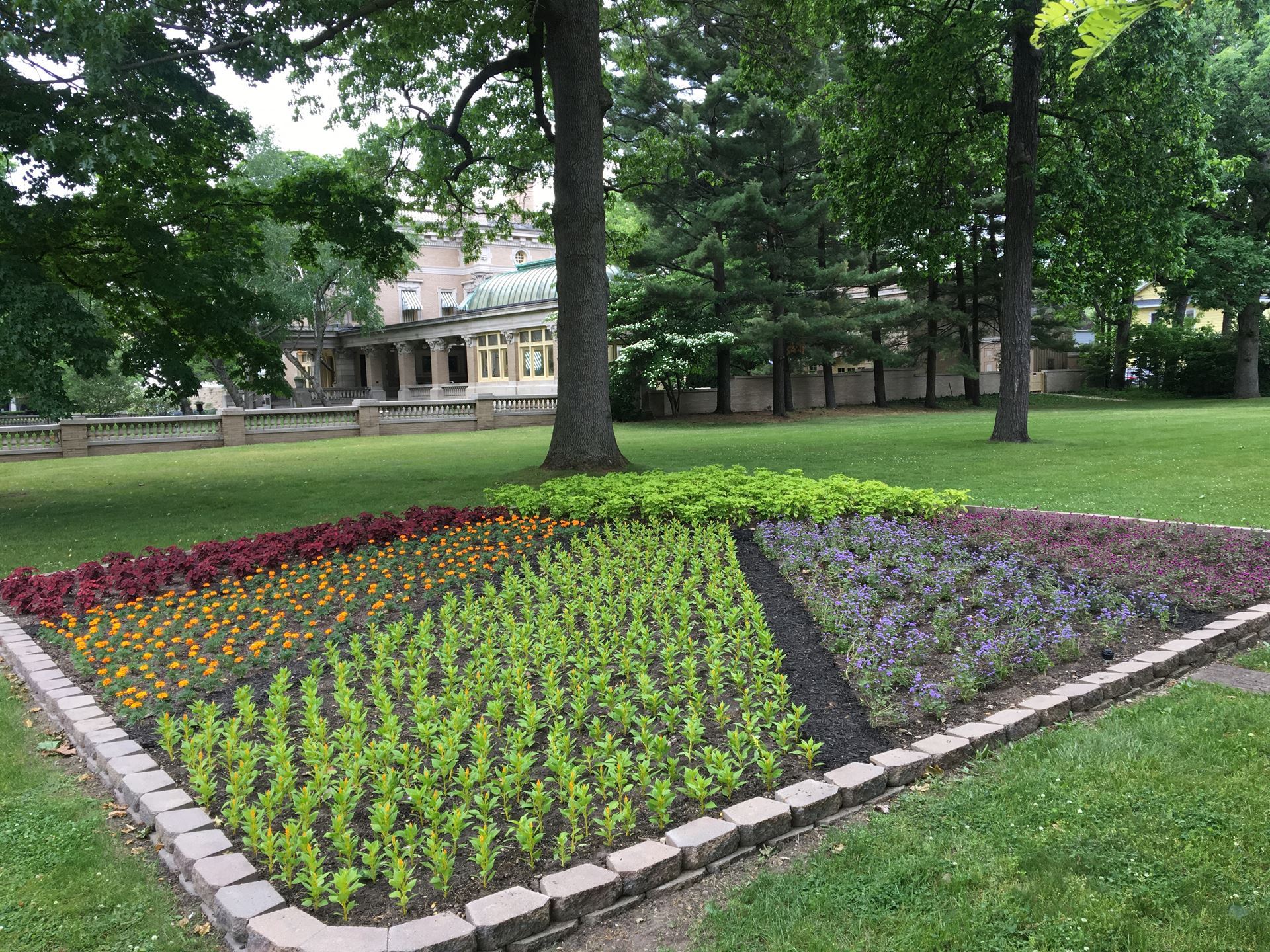


 Ruth's Chrysanthemum was selected due to its diversity in color and the way it looks on a flatbed for viewing. The chrysanthemum was loved by the late Victorians and became especially popular in the early 20th century, when Ruthmere was built. Pink was the chosen color in remembrance of Ruth, the infant daughter of Albert and Elizabeth Beardsley and Ruthmere's namesake who died when she was still a baby.
Ruth's Chrysanthemum was selected due to its diversity in color and the way it looks on a flatbed for viewing. The chrysanthemum was loved by the late Victorians and became especially popular in the early 20th century, when Ruthmere was built. Pink was the chosen color in remembrance of Ruth, the infant daughter of Albert and Elizabeth Beardsley and Ruthmere's namesake who died when she was still a baby.
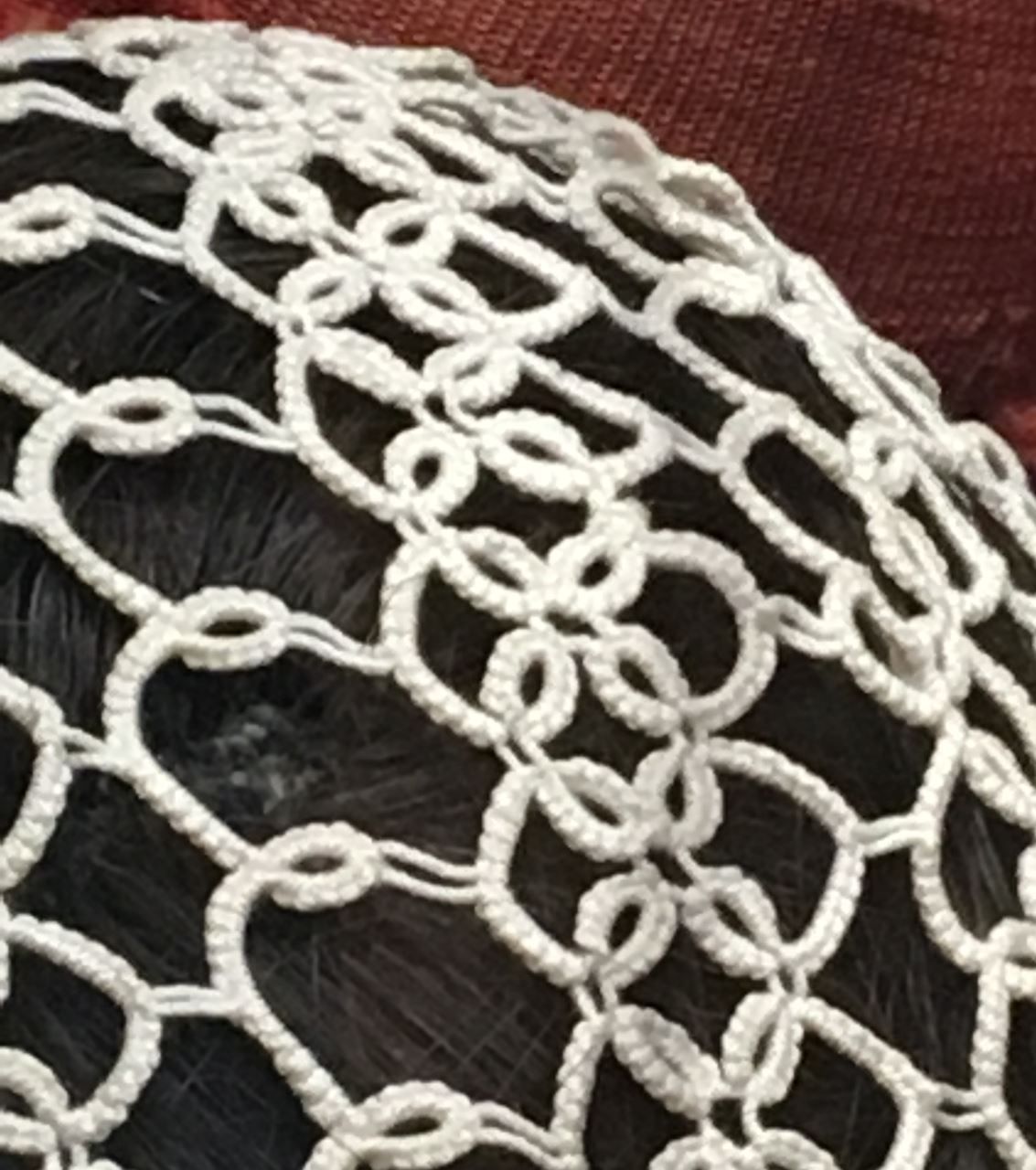 The “Joseph’s Coat” quilt-block pattern dates back to the 1930s and reflects the history of Ruthmere. It is a natural fit for this location as the pattern can be found in some of the treasures inside. While on a tour of Ruthmere, you may want to look for the design throughout the mansion.
The “Joseph’s Coat” quilt-block pattern dates back to the 1930s and reflects the history of Ruthmere. It is a natural fit for this location as the pattern can be found in some of the treasures inside. While on a tour of Ruthmere, you may want to look for the design throughout the mansion.
 The “Bow Tie” quilt-block pattern dates back to the late 1800s and reflects the history of the residence and the black-tie events that were hosted by the Beardsleys as well as current events offered by the Museum, such as our fundraisers and galas. In keeping with those memorable parties, the Quilt Garden is all decked out with a black bow tie of Black Dragon Coleus resting on a field of Olympia Super White Begonias.
The “Bow Tie” quilt-block pattern dates back to the late 1800s and reflects the history of the residence and the black-tie events that were hosted by the Beardsleys as well as current events offered by the Museum, such as our fundraisers and galas. In keeping with those memorable parties, the Quilt Garden is all decked out with a black bow tie of Black Dragon Coleus resting on a field of Olympia Super White Begonias.

 The Crossed Canoes pattern dates back to 1895. There are so many ways to tell a story and in this case the telling is in
The Crossed Canoes pattern dates back to 1895. There are so many ways to tell a story and in this case the telling is in 
 As in other years, we looked for inspiration within the walls of our historic home. Ruthmere has 292 pomegranate (we recently found 3 more than previously thought) decorations inside and out adorning the mansion. The quilt garden reflects this design motif unique to Ruthmere. Notice in the picture above the restoration work happening in the background at Ruthmere's greenhouse.
As in other years, we looked for inspiration within the walls of our historic home. Ruthmere has 292 pomegranate (we recently found 3 more than previously thought) decorations inside and out adorning the mansion. The quilt garden reflects this design motif unique to Ruthmere. Notice in the picture above the restoration work happening in the background at Ruthmere's greenhouse.
 As in previous years, we looked for inspiration within the walls of our historic home. The entrance to the front foyer of Ruthmere offers a recognizable archetype that is rich with symbolism, the “infinity" pattern.
As in previous years, we looked for inspiration within the walls of our historic home. The entrance to the front foyer of Ruthmere offers a recognizable archetype that is rich with symbolism, the “infinity" pattern.
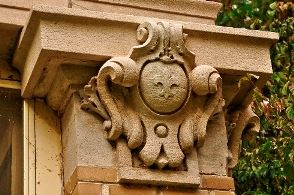 For 2013, our quilt garden design comes from the iconic French fleur-de-lis often seen as a decorative motif on Ruthmere's Beaux Arts exterior.
For 2013, our quilt garden design comes from the iconic French fleur-de-lis often seen as a decorative motif on Ruthmere's Beaux Arts exterior. 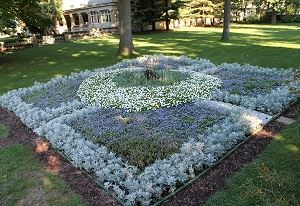
 For 2012, our quilt garden is inspired by Ruthmere's blue and white wedding garden located inside the wall on the mansion grounds. Every year many couples choose to have their wedding in this historic garden.
For 2012, our quilt garden is inspired by Ruthmere's blue and white wedding garden located inside the wall on the mansion grounds. Every year many couples choose to have their wedding in this historic garden.


